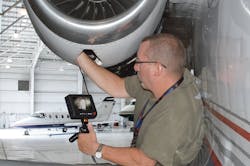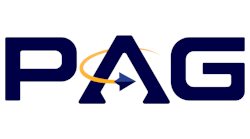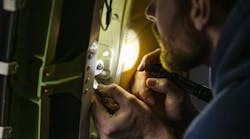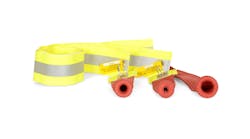As the only FBO at the Rochester International Airport, in Rochester, NY, USAirports maintains a very busy schedule, including the responsibility of conducting a wide variety of inspections on general aviation aircraft ranging from a single-engine Cessna to business jets, and also operates and maintains its own charter department where aircraft readiness is paramount. That means the maintenance teams need to quickly diagnose any problems they might find and either begin repairs, or refer the client to specialized repair facilities. Fast, accurate, visual inspection is an irreplaceable part of the process.
“Aircraft are mechanical and occasionally they break. We do our best to assist our customers,” says Jim Thayer, USAirports’ director of maintenance. “As an FAA certified repair station, we have the service manuals on file for whatever aircraft we work on. We also service the airlines with “on-call” maintenance. If they have an issue we will go over and assist them. If we can fix it quickly we do. If the problem is more complex, or if they have to send parts, we will send mechanics and assist them as needed with support or tools, etc.,” Thayer says.
Fast, reliable inspections
“Fast, reliable, visual inspection is essential to everything we do,” Thayer says. “Often what we need to see is very hard to access. That’s when we use a borescope. The portable Hawkeye V2 Videoscope we use gives us the ability to take the scope to any part of the aircraft. Even more valuable is the teardown time it saves us, often just to take a quick look at something. Visual inspection is 90 percent of what we do for inspection. We can insert a borescope and immediately have visual access to areas that we wouldn't be able to reach without some major disassembly,” Thayer says.
“Sometimes there is no access other than a small drain-hole we can only get a 4 mm scope through,” Thayer continues. “One example that comes to mind is the Beechjet. The horizontal stabilizer has an issue with the side roller brackets cracking. There have been issues with these over the years and there is a repetitive inspection for this. In order to get in there and do the inspection you really need some type of borescope. We use a 4 mm videoscope, which allows us to access some very small drain holes in the horizontal stabilizer. There is just no way to visually get in there unless you start drilling out rivets and removing skin. You could X-ray it and find the cracks, but that would be very expensive and time consuming.”
Save on disassembly
Engine disassembly, for purposes of visual inspection, can be the most prohibitive. Borescopes can be the only way to get in - especially inside turbine engines. Borescopes are also used in piston engines, on occasion, in order to get a look down inside cylinders. Investigating possible scoring inside a cylinder is one common example of a need for visual inspection. Once inside, a flexible videoscope, with articulation capability, can “look back” almost 180 degrees to inspect the valves.
“In the past, we used different flexible fiber-optic scopes,” Thayer says. “However, today’s videoscopes have superior image quality, and still have the flexibility and articulation we were used to. The portability of today’s videoscopes is also a key factor. You don't need any external lights or extension cords. One of our tenants had a Beechjet and they wanted to look at their side roller brackets in the horizontal stabilizer. They called me and asked me to come over with my videoscope so they could look at them. You just climb up the ladder and everything is right in your hands. You don't have to worry about pulling cords with you. It is very convenient.”
Capture data
Today, a videoscope also allow users to capture still photos and record quality video footage. This allows maintenance teams to completely document an inspection, and review what they’ve seen with customers, colleagues, or manufacturers. Videoscopes have the capability of capturing sharp pictures, or video footage, even when the scope is very close to the subject. That’s something that’s always an issue in engines and airframes. Images and video can be captured and emailed to engineers, if a maintenance team is looking for guidance in solving a problem. Photos and video can also be sent to engine manufacturers asking for help in clarifying what the onsite teams are seeing.
“To describe something verbally is one thing, but if you can send a photograph with it, it just makes things so much clearer,” Thayer says. “Photos and videos of inspections also allow maintenance teams to enhance trend monitoring. That becomes especially valuable for larger fleets.”
Closer inspection
“If you are looking at or doing an inspection on rudder pedal mounts, for example, typically you are pulling floor boards and having to crawl under an instrument panel and you still can't really get in as close as you’d like. You can't get a magnifying glass there, so videoscopes allow, closer, better inspection and evaluation,” Thayer says.
“Another good example is the engine nacelle anti ice duct inspection on the Beechjets. We inspect the ducts periodically for cracks in the mounting welds. There are four welds on the bracket that we have to inspect and we are going to use the videoscope to do it. (See photos). Without the videoscope the process is a lot more cumbersome.
"Two of the welds you can just look at with a flashlight, but there are two welds, because of the angle of them, you cannot get a mirror up in there. You have to get two mirrors up in there to see the backside welds. These welds have been known to crack. That is why this inspection has been stipulated every 200 hours. We have actually found cracked welds where we have had to replace the duct assembly. It is a very important inspection.”
Get inside engines
Visual inspection is, of course, also key to engine inspections. Typical engine inspections, for example, include oil filters, fuel filters, etc. The igniters are pulled and a general visually inspection of components is conducted. In addition, the use of a videoscope, gives the inspector the ability to look inside the combustion chamber quickly and easily. Fuel nozzles can be viewed to see if there is any streaking which can cause hot spots. Within the burner can itself, you can look for cracking in hot spots from nozzle issues, for cracks, erosion, or anything that might be detrimental to the burner can itself.
It appears clear that today’s videoscopes are lightweight, fully portable, and a key tool in any FBO or repair station.
For more information visit www.usairports.com and www.gradientlens.com/V2.




